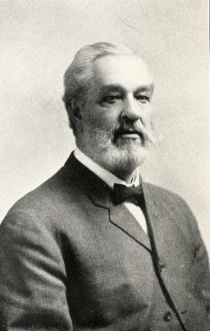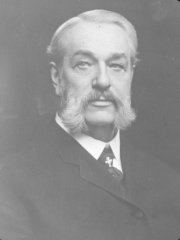Jirah Dewey Buck
Dr. Jirah Dewey Buck (November 20, 1838 - December 13, 1916) was a physician who worked to establish one of the first Theosophical lodges in the United States, the Cincinnati Theosophical Society, and the American Section of the international Theosophical Society in 1886.
Early life
Buck was born in Fredonia, New York on November 20, 1838 to Reuben Buck and Fanny Morton. He was educated at Belvidere Academy in Belvidere, Illinois.[1]
Career in medicine
Jirah Buck received his medical training at Cleveland Homeopathic Medical College, completing the program in 1864. He began practice that year in Cincinnati as a homeopathic physician in general practice. He also taught medicine at Cleveland Medical College, and became Dean of the Pulte Medical College in Cincinnati until it was merged into Ohio State University.[2] In 1890 Dr. Buck became President of the American Institute of Homeopathy.[3] He practiced medicine for over 40 years.
Family life
Dr. Buck married Melissa M. Clough (1838-1908) in 1865. They had six children: Alice, Cora, Edgar, Charles, Robert, and Ruth. Mrs. Buck and Cora were very active in the Cincinnati Theosophical Society, and other family members were also involved. On December 27, 1885, six of them became members: Lissie Clough Buck, her sisters Della and Nellie Clough, and children Alice, Cora, and Edgar.[4] Edgar became a physician, and practiced in Kentucky for a time before returning to Cincinnati. There, in 1910, Edgar had taken his wife and son to live with J. D., Cora, and Robert, an electrical engineer. Mrs. Melissa Buck died in 1908.[5]
Theosophical Society activities
Dr. Buck became active in the Theosophical Society in 1879.[6] In 1880, he was a member of the General Council of the Theosophical Society.[7] On May 13, 1884, he was appointed by Col. Olcott to be a member of the Board of Control of the Theosophical Society's activities in the United States.[8]
In Mahatma Letter 140, written in March, 1886, Madame Blavatsky gave A. P. Sinnett an indication that Dr. Buck was being "helped" by the Mahatmas to make the Society "a grand movement" in America.[9] The Cincinnati Theosophical Society was formed on May 9, 1886 at the Buck home on Oak Street, and on October 30 of that year a convention was held there to establish the American Section of the Theosophical Society. Dr. Buck presided over that assembly.
Madame Blavatsky quoted an essay of his in The Key to Theosophy saying, "No living theosophist has better expressed and understood the real essence of Theosophy than our honoured friend Dr. Buck".[10] She also referred to him as "a true Philaletheian" in her book, quoting from an article he published in The Theosophist (September 1883, p. 327) titled "The Ethics of Theosophy."[11]
Dr. Buck conducted a cordial correspondence with Mme Blavatsky, but never met her in person. "In the year of her death, he sailed for London with Mrs. Buck and Annie Besant to make H. P. B.'s personal acquaintance. But while they were on the ocean H. P. B.'s body was deserted by its soul, and the travellers saw nothing on arrival but her empty room"[12]
At the 1893 World's Parliament of Religions, Dr. Buck delivered an address, "Theosophy Historically Considered as Underlying All Religions and Sacred Scriptures - Esotericism in Religions and Philosophies."
Masonry
In an obituary in The Builder, one of his fellow Masons wrote,
Dr. Buck was an active and influential member of every Rite of our historic Order, holding the highest rank both in the esteem of his Brethren and in the gift of the fraternity --including the honorary Thirty-Third Degree of the Scottish Rite in its Northern Jurisdiction. Indeed, he was a recognized leader of a definite school of Masonic thought and propaganda; and while we have never been able to agree with all the conclusions of the school which he represented, we are none the less appreciative of its services to the Craft--knowing that Truth is larger than the formula of any one school or of all schools put together...
His Masonry, on one side, was a spiritual patriotism in the exposition of which he was truly and impressively eloquent. In behalf of free thought, free conscience, and the sovereign right of man to worship in the way his heart loves best, he was a crusader--as every Mason must be.[13]
This is confirmed in another obituary in the Cincinnati Enquirer:
Dr. Buck's writing and lectures on Masonry for the past 15 years made him known the world over. .. The doctor was thirty-second degree Mason, and was regarded by many as the leading authority in the world on Masonry. He was a member of Avon Lodge, Hanselmann Commandery, Wilsinning Chapter, and the Scottish Rite. He was also a member of the Literay and Cosmic Clubs.[14]
Another Freemason who was a particular friend of his was James Ralston Skinner. In his book Modern World Movements, Buck describes conversations with Skinner about the Hebrew language and correspondence with Madame Blavatsky.[15]
Later years
After the death in 1896 of William Quan Judge, Dr. Buck seems to have been disappointed with the direction of the Theosophical movement.
Buck followed Hargrove for a time, and succeeded him as TSA president in 1900. He soon left to join another Judge-lineage group, the Temple of the People, based in Syracuse, New York, but resigned after its headquarters were moved to California in 1903. Buck's final affiliation was with "T.K.," John E. Richardson, and his Masonically-inspired Great Work. Buck died on December 16, 1916, having been disappointed once again as Richardson was publicly exposed as a financial fraud when the Great work organization collapsed earlier that year.[16]
Local newspapers give Buck's date of death as December 13, but it was not recorded in public records until the 16th.[17][18]
Writings
Buck contributed Theosophical articles to several journals including The Path, The Theosophist, and Lucifer. The Union Index of Theosophical Periodicals lists 64 articles under the name JD Buck, 5 under J. D. Buck, 4 under JDB, and one under the pseudonym Hiraj (Jirah spelled backward).
In addition he published these books and pamphlets:
- The Nature and Aim of Theosophy. An Essay, etc.. Cincinnati: R. Clarke & Co., 1886. Cincinnati: R. Clarke & Co.,1889 (second edition). An essay read before the Cincinnati Literary Club, January 17, 1886. Also published in Swedish in 1889.
- Browning's Paracelsus, and Other Essays. Cincinnati: R. Clarke & Co., 1887.
- A Study of Man and the Way to Health. Cincinnati: R. Clarke & Co., 1889.
- The Perfect Man is the Anthropomorphic God, Christos. Chicago: Hermetic Publishing Company, 1889. Available at Internet Archive.
- Mystic Masonry: or, The Symbols of Freemasonry and the Greater Mysteries of Antiquity. Cincinnati: R. Clarke Co., 1897. Supplemental Harmonic Series - Volume III. Multiple editions, such as Chicago: Indo-American Book Co., 1911. (First American edition, 5th regular edition) The third edition was renamed Symbolism of Free Masonry or Mystic Masonry and the Greater Mysteries of Antiquity, published in 1925 by Ezra A. Cook, Chicago. Also published in the German language: Berlin: Verlag bei Paul Zillmann, 1908. Available at Internet Archive.
- Genius of Freemasonry and the Twentieth-Century Crusade. Chicago: Indo-American Book Co, 1907. Supplemental Harmonic Series - Volume I. Available at Internet Archive.
- Constructive Psychology: or, The Building of Character by Personal Effort. Chicago, Indo-American Book Co., 1908. Supplemental Harmonic Series - Volume III. Copenhagen Business School has an electronic version that requires a logon ID and reader. Available at Internet Archive.
- The Lost Word Found in the Great Work Magnum Opus. Chicago, 1909.
- The Soul and Sex in Education. 1909.
- Modern World Movements: Theosophy and the School of Natural Science. Chicago: Indo-American Book Co., 1913. Supplemental Harmonic Series - Volume VII. Available at Internet Archive and at Blavatsky Archives. This book compares a Los Angeles organization called the Great School of Natural Sciences with the Theosophical Society.
Notes
- ↑ Arthur Wayne Hafner, ed. Directory of Deceased American Physicians, 1804-1929: a Genealogical Guide to Over 149,000 Medical Practitioners Providing Brief Biographical Sketches Drawn from the American Medical Association's Deceased Physician Masterfile. Chicago: American Medical Association, 1993.
- ↑ Arthur Wayne Hafner, ed. Directory of Deceased American Physicians, 1804-1929.
- ↑ Boris de Zirkoff, "Bibliography: Buck, Dr. Jirah Dewey," H. P. Blavatsky Collected Writings 1881-1882 Volume III (Wheaton, IL: Theosophical Publishing House, 1968), 498-499.
- ↑ Theosophical Society General Membership Register, 1875-1942 at http://tsmembers.org/. See book 1, entries 3519-3524 (website files: 1B/17 and 1B/18).
- ↑ U.S. Census for 1910.
- ↑ Theosophical Society General Membership Register, 1875-1942 at http://tsmembers.org/. See book 1, entry 1196 (website file: 1A/39).
- ↑ "The Theosophical Society," The Theosophist 1.8 (May, 1880), 214.
- ↑ George E. Linton and Virginia Hanson, eds., Readers Guide to The Mahatma Letters to A. P. Sinnett (Adyar, Chennai, India: Theosophical Publishing House, 1972), 222.
- ↑ See Page 6 in Mahatma Letter 140.
- ↑ Helena Petrovna Blavatsky, The Key to Theosophy (Pasadena, CA: Theosophical Universtity Press, 1972), 16.
- ↑ Helena Petrovna Blavatsky, The Key to Theosophy (Pasadena, CA: Theosophical Universtity Press, 1972), 53.
- ↑ Anonymous, "Faces of Friends," The Path 7 (January 1893), 319-20.
- ↑ Joseph Fort Newton, "J. D. Buck: A Militant Mason," The Builder (February 1917). Available at MasonicDictionary.com
- ↑ Anonymous. Cincinnati Enquirer (December 13, 1936): 6.
- ↑ See Blavatsky Archives.
- ↑ Patrick D. Bowen and K. Paul Johnson, eds. "J. D. Buck" [biographical sketch] Letters to the Sage: Selected Correspondence of Thomas Moore Johnson Volume One: The Esotericists (Forest Grove, OR: The Typhon Press, 2016), 107.
- ↑ Arthur Wayne Hafner, ed. Directory of Deceased American Physicians, 1804-1929: a genealogical guide to over 149,000 medical practitioners providing brief biographical sketches drawn from the American Medical Association's Deceased Physician Masterfile. Chicago: American Medical Association, 1993.
- ↑ "Jirah D. Buck" Ohio, U.S., Death Records, 1908-1932, 1938-2018.
Additional resources
- Correspondence and other archival materials related to Dr. Buck's activities in the Theosophical Society are in the Theosophical Society in America Archives. Records Series 20.02.01. Cincinnati Theosophical Society Records. Theosophical Society in America Archives, Wheaton, Illinois.
- See also Damodar and the Pioneers of the Theosophical Movement (book), p. 184; A Short History of the Theosophical Society (book) index (many references).

